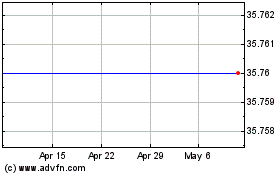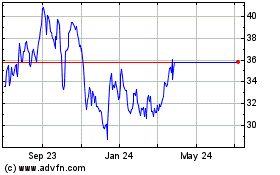Oil prices fell below $40 a barrel Wednesday amid a growing
glut, putting more pressure on an industry that already is a major
weak spot for global growth.
The immediate cause was a 10th straight weekly rise in U.S.
inventories of crude oil at a time of year when they are expected
to shrink. The market's broader problem, however, is that producers
in OPEC and the U.S. are locked in a battle for market share that
has left the world flooded with oil.
For the past several months, Saudi Arabia has led a policy of
raising oil output to squeeze presumably weaker U.S. rivals in the
U.S. and other countries. But American producers have proved
surprisingly resilient, thanks to deep cost cuts and support from
banks that have kept loans flowing, helping the industry weather
the market's collapse.
The standoff—and discontent with the Saudi policy— is coming to
a head at this week's meeting of the Organization of the Petroleum
Exporting Countries. So far, the kingdom has shown little
willingness to budge.
Late Wednesday, people familiar with the matter said Saudi
Arabia and other Persian Gulf states are willing to cut output as
long as Iran and non-OPEC producers do their part as well.
"We cannot cut alone," one Gulf official said. "Everyone has to
contribute."
Crude-oil futures fell 4.6% to $39.94 in New York on Wednesday,
leaving them down about 25% for the year. Brent, the global
benchmark, fell 4.4% to $42.49 on ICE Futures Europe.
There are signs that cheap oil has benefited industries and
consumers, who are able to spend what they save at the pump. But
the economic calculus has become more complex now that the U.S. has
become a major oil producer in its own right, with the industry a
key source of jobs and orders and with energy stocks and bonds
widely held. The decline in crude has kept inflation subdued,
complicating central bankers' approach to monetary policy.
Oil prices last closed below $40 in the U.S. in late August,
when worries about the global economy roiled financial markets.
Some investors think oil prices will have to spend a long time
around these levels to force producers to give up.
"Prices have to stay low," said Lee Kayser, portfolio manager at
Russell Investments, which manages $237 billion, including $1.6
billion in commodities. "We haven't seen a large-scale flush-out.
We haven't seen many bankruptcies that seem like a sign of the
bottom."
The consequences of the price decline have been severe.
Companies have either deferred or canceled $625 billion of
investments in oil and gas projects that was due to be spent over
the next five years, according to investment bank Tudor, Pickering,
Holt & Co. More than 250,000 people world-wide have lost their
jobs, said Houston consulting firm Graves & Co.
The cuts have helped companies reduce costs and keep pumping
even though prices are now below break-even levels in many
fields.
Meanwhile, supplies are swelling. U.S. commercial inventories of
crude oil and fuel last week soared above 1.3 billion barrels, a
record, according to a report released Wednesday by the U.S. Energy
Information Administration.
Some analysts and investors say the time of reckoning has been
pushed back several months as banks prove reluctant to turn off the
taps.
In their latest review of oil and gas deposits used as
collateral for corporate loans, banks were more lenient than many
investors and analysts anticipated. Lenders shaved an average of
8.6% off the amount companies can borrow so far in the second half
of 2015, according to an analysis by Oil & Gas Financial
Analytics LLC. Industry executives polled by law firm Haynes and
Boone LLP in September expected cuts to average 39%.
As a result, many small and midsize U.S. energy companies have
maintained access to credit lines that allow them to keep pumping
oil and adding to the global supply glut. Banks are inclined to
support producers so the producers can repay their loans in cash
instead of in oil and natural-gas reserves.
Many highly indebted companies have drilled and produced as much
oil and natural gas as possible this year to maximize their cash
flows, keeping total U.S. crude output high and weighing on
prices.
The EIA said Monday that U.S. production averaged 9.3 million
barrels a day in September—down just 2.7% from a 43-year peak in
April.
Although more than three dozen producers have already filed for
bankruptcy protection this year, they have mostly been small
companies that, when taken together, don't produce much crude.
Some investors are eager for banks to take a tougher line.
"From an investor standpoint, it's been, 'Come on already, rip
off the Band-Aid!'" said Janelle Nelson, vice president at RBC
Wealth Management, which manages $280 billion. "I want the pain to
be over with quickly, so that I can piece through all the carnage
and find the good stuff."
The robustness of U.S. output has tested OPEC's yearold policy
of pumping up production to force weaker players out of the market.
During past market downturns, OPEC had cut back its own supplies.
But this time, Saudi officials believed a period of low prices was
needed to squeeze out producers that depended on high oil prices to
survive.
In the U.S., regulators are concerned about banks' energy-sector
loans, and the outcome of this latest semiannual assessment of
energy reserves could prompt more scrutiny. In November, the
Federal Reserve, Office of the Comptroller of the Currency and
Federal Deposit Insurance Corp. said in a report that banks hold a
high number of troublesome loans.
Not all producers got a pass. Oasis Petroleum Inc. and SM Energy
Co., companies that operate in shale-rock regions, each reported
that their borrowing bases were cut by more than 10%. Oasis
declined to comment. SM Energy said its base was cut because it
sold assets.
But the borrowing bases at many firms, such as RSP Permian Inc.,
Northern Oil & Gas Inc. and Bill Barrett Corp., were either
left unchanged or even marked higher in recent months, according to
company disclosures. Callon Petroleum Co., which operates in the
prolific Permian Basin in West Texas, said in October its borrowing
base rose 20% to $300 million.
Callon decided "in January, when we saw the downturn…that we
needed to get as close as we can to our lending banks," said Joseph
Gatto Jr., chief financial officer, according to a transcript of
comments made at an industry conference in November. Among the
company's 10 banks, he said, "everyone is very supportive." Callon
didn't respond to requests for comment.
Producers have slashed spending, but their output is still high
due to improved efficiency, the fact that large-scale projects were
already under way and continued access to equity and debt markets
in the first half of the year.
"If you had asked me this summer, 'Are the banks going to
tighten the screws here in the fall?' Yeah, absolutely," said Will
Nasgovitz, portfolio manager at Heartland Advisors, which oversees
$3 billion. "Now I think it's going to be next spring."
Summer Said
Subscribe to WSJ: http://online.wsj.com?mod=djnwires
(END) Dow Jones Newswires
December 02, 2015 19:45 ET (00:45 GMT)
Copyright (c) 2015 Dow Jones & Company, Inc.
Callon Petroleum (NYSE:CPE)
Historical Stock Chart
From Mar 2024 to Apr 2024

Callon Petroleum (NYSE:CPE)
Historical Stock Chart
From Apr 2023 to Apr 2024
